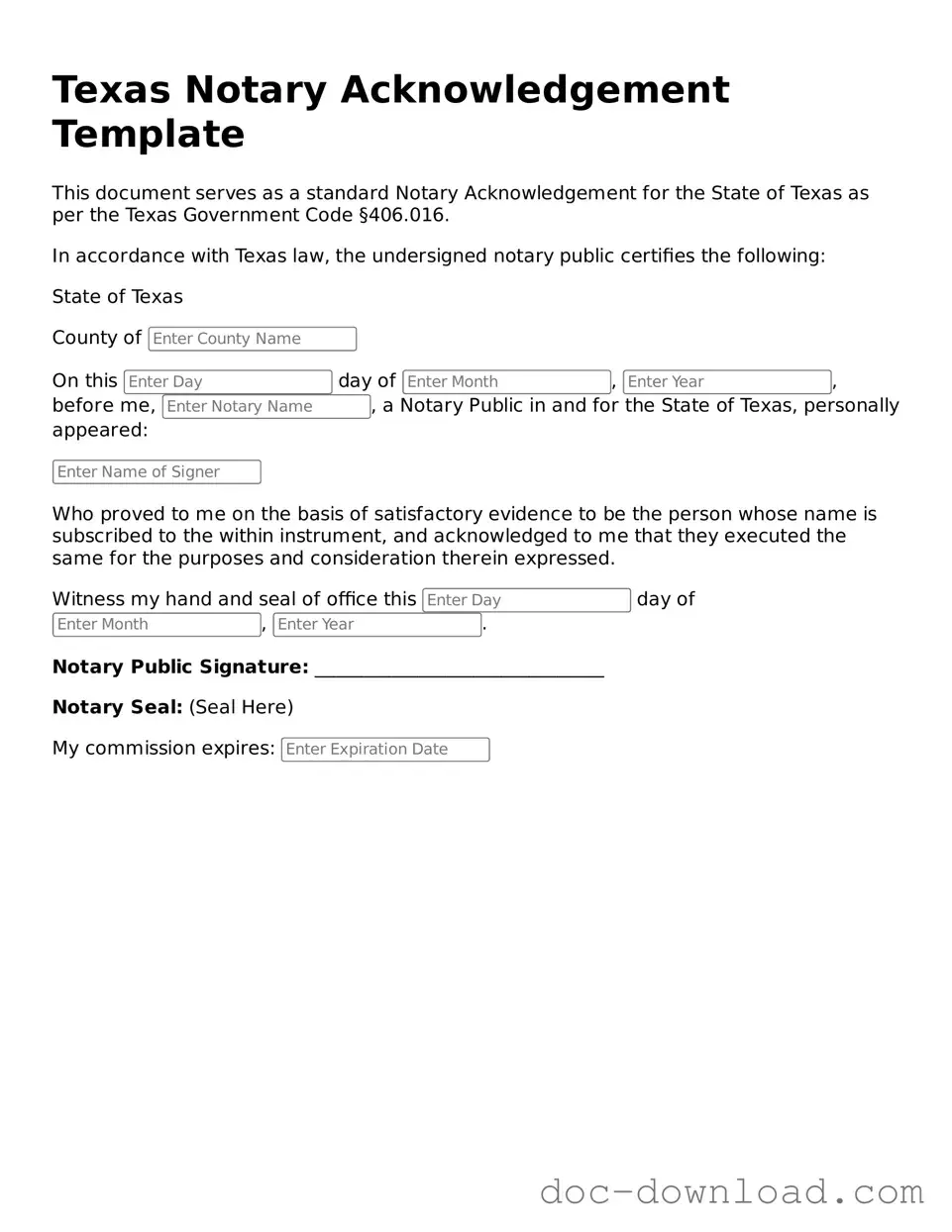The Texas Notary Acknowledgment form is similar to the Affidavit form, which is used to declare something as true under oath. Like the Notary Acknowledgment, an Affidavit requires a notary public to verify the identity of the signer. Both documents serve as a means of providing assurance that the statements made are genuine and can be relied upon in legal matters. The primary difference lies in the purpose; while the Acknowledgment confirms the signing of a document, the Affidavit asserts facts that are sworn to be true.
Another document akin to the Texas Notary Acknowledgment is the Jurat. A Jurat is a notary's certification that a signer has sworn to the truth of the contents of a document. Similar to the Notary Acknowledgment, a Jurat requires the presence of a notary public during the signing process. The key distinction is that a Jurat involves an oath, while an Acknowledgment simply verifies that the signer is who they claim to be and that they willingly signed the document.
The Power of Attorney (POA) form also shares similarities with the Texas Notary Acknowledgment. Both documents often require notarization to be legally binding. A Power of Attorney grants someone the authority to act on another's behalf, and the notary's role is to confirm the identity of the principal and ensure that the signing is voluntary. The Notary Acknowledgment, on the other hand, merely confirms the act of signing without granting any powers.
The Deed form is another document that resembles the Texas Notary Acknowledgment. When transferring property ownership, a Deed must be signed in the presence of a notary to ensure its validity. Like the Notary Acknowledgment, the notary verifies the identity of the signers and confirms that they are signing willingly. The Deed, however, serves a specific purpose of transferring property rights, whereas the Acknowledgment focuses on the authenticity of the signing process.
The Affidavit of Identity is closely related to the Texas Notary Acknowledgment as well. This document is used to confirm a person's identity, often in situations where there may be confusion or disputes. Both documents require notarization to validate the information provided. The main difference is that the Affidavit of Identity is specifically tailored to address identity verification, while the Notary Acknowledgment pertains to the act of signing a document.
For individuals seeking to manage their affairs effectively, exploring a Durable Power of Attorney form template can provide clarity on the process. This document empowers a designated agent to make decisions, ensuring that your preferences are honored even in times of incapacity.
Another document that shares characteristics with the Texas Notary Acknowledgment is the Certificate of Acknowledgment. This certificate is often attached to a document to prove that it was acknowledged by a notary. Similar to the Acknowledgment form, it requires the notary to confirm the identity of the signer and ensure they understand the document they are signing. However, the Certificate of Acknowledgment is more of a supplementary document, while the Acknowledgment form itself serves as a standalone verification.
The Bill of Sale is also comparable to the Texas Notary Acknowledgment. When selling personal property, a Bill of Sale may be notarized to provide additional proof of the transaction. Both documents require the notary to verify the identities of the parties involved. The Bill of Sale serves as a record of the sale, while the Acknowledgment primarily focuses on confirming that the document was signed willingly and by the correct individuals.
Lastly, the Release of Liability form has similarities to the Texas Notary Acknowledgment. This document is often used to protect one party from legal claims arising from an activity. Notarization is typically required to ensure that the person signing the Release understands the implications of the document. Both forms require the notary to confirm the identity of the signer, but the Release of Liability specifically addresses the relinquishing of legal rights, whereas the Acknowledgment focuses on the act of signing itself.
